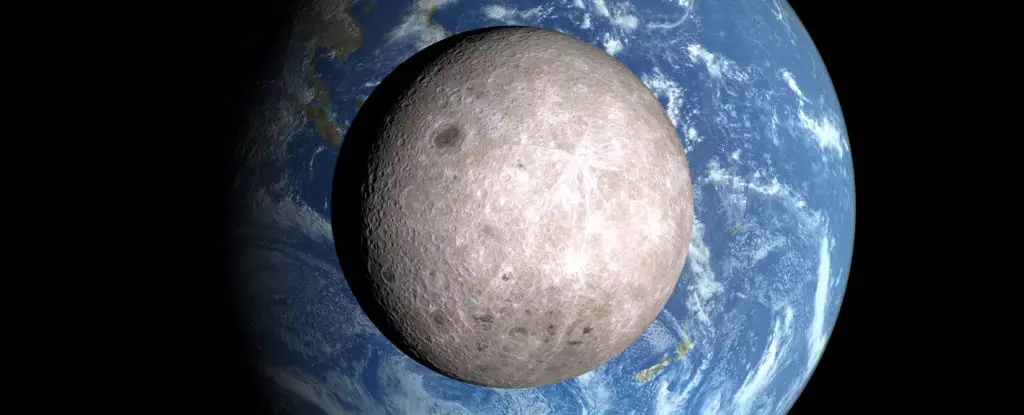The Moon, Earth’s eternal companion, has long intrigued scientists with its myriad of mysteries, one of which is the puzzling distribution of water within its crust. Recent findings reveal that water on the Moon is not evenly distributed. Research led by scientists from the Chinese Academy of Sciences indicates that the far side of the Moon— the hemisphere that permanently faces away from Earth—exhibits significantly lower water concentrations compared to its near side. This revelation opens a cascade of questions about the Moon’s formation, geological history, and the evolution of its surface.
The disparity in water abundance is striking, especially given the visual differences in the two Moon hemispheres. The near side is characterized by vast, smooth basaltic plains—known as maria—formed by ancient volcanic activity. In contrast, the far side boasts a battleground of craters, presenting a rugged landscape that lends itself to speculation about the Moon’s past. These two distinct surfaces suggest a rich tapestry of geological activity, influenced by their unique environments.
Examining the Origins of the Lunar Water Dichotomy
Central to understanding this water distribution is the prevailing model of the Moon’s genesis. The leading theory posits that approximately 4.5 billion years ago, a planet-sized body dubbed ‘Theia’ collided with the primordial Earth. The resulting debris formed the Moon, which initially may have been molten. As this lunar magma ocean cooled down, the near side underwent extensive volcanic activity, allowing for the creation of those expansive maria.
Given this history, it’s perplexing to find that the far side is seemingly less hospitable to water-retaining geological features. The hypothesis of uneven cooling dynamics is particularly compelling, as the proximity of the near side to Earth likely resulted in a significant thermal gradient. The heat emanating from Earth may have inhibited the cooling process on the near side, allowing for more pronounced volcanic activity and thereby fostering the creation of maria.
Insights from the Chang’e-6 Mission
The breakthrough came with China’s Chang’e-6 mission, which successfully retrieved samples from the Moon’s far side. This endeavor provided scientists with a rare opportunity to conduct a detailed chemical analysis of lunar materials and examine the hydrous content in the geological samples collected from the South Pole-Aitken Basin—an enormous impact structure on the far side.
Using advanced techniques such as scanning electron microscopy, researchers led by Huicun He and Linxi Li scrutinized the samples for signs of water, particularly within the mineral compositions of olivine and ilmenite. The results were nothing short of astonishing: the basalt originating from the far side revealed a stark lack of water, with concentrations estimated at merely 1 to 1.5 micrograms per gram. This finding not only underscores the existing models about the Moon’s formation but also hints at broader implications for our understanding of lunar volcanism and surface development.
The Implications of Lunar Water Distribution
Understanding the lunar water distribution is pivotal for several reasons. Firstly, it enriches our knowledge about the Moon’s geological evolution and the processes that shaped it. The scarcity of water on the far side could reflect post-impact alterations where material was displaced during the formation of the South Pole-Aitken Basin—a cataclysmic event that might have propelled debris toward the near side, thus altering their geological narratives.
Moreover, the study of lunar water has far-reaching implications beyond geological curiosity. The presence of water—whether from impact deposits, trapped in minerals, or existing as ice—on the Moon can serve as a critical resource for future lunar exploration and even colonization. The revelations from the far side raise the stakes for future missions, as they indicate not only resource disparities but also potential challenges in sustaining human life or habitats on the Moon.
Future Missions and the Path Forward
As we grapple with these discoveries, the question arises: what lies ahead for lunar exploration? The insights gained from Chang’e-6 have provided a significant platform, but they also emphasize the need for further sampling across different regions of the Moon. A comprehensive understanding of the geological and chemical composition of the lunar interior is essential for validating or revising existing models of lunar evolution.
The future of lunar exploration is bright with potential. As we prepare for upcoming missions—both crewed and uncrewed—scientists are called to delve deeper into the Moon’s secrets. Understanding the Moon’s patchy chemical landscape may change our perspective not only of our celestial neighbor but also of the early solar system and the genesis of planets. Indeed, the Moon continues to be a treasure trove waiting to be unlocked, an eternal reminder of our quest for knowledge.


Leave a Reply